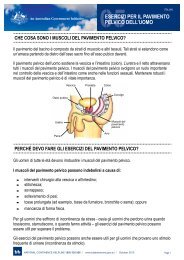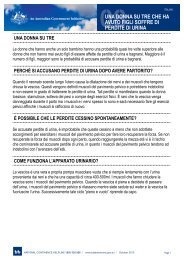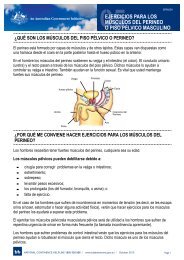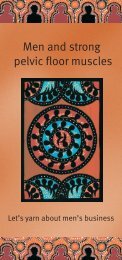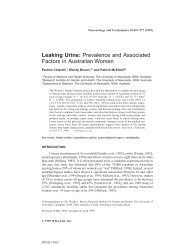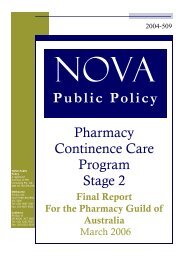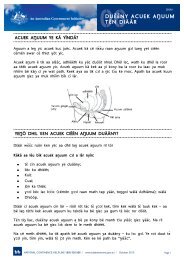Continence Tools for Residential Aged Care - Bladder and Bowel ...
Continence Tools for Residential Aged Care - Bladder and Bowel ...
Continence Tools for Residential Aged Care - Bladder and Bowel ...
You also want an ePaper? Increase the reach of your titles
YUMPU automatically turns print PDFs into web optimized ePapers that Google loves.
10. Linking the <strong>Continence</strong> tools to the <strong>Aged</strong> <strong>Care</strong><br />
Funding Instrument<br />
In March 2008, the Department of Health <strong>and</strong> Ageing<br />
introduced an <strong>Aged</strong> <strong>Care</strong> Funding Instrument (ACFI)<br />
as a resource allocation instrument <strong>for</strong> residential aged<br />
care. When completed, the ACFI allows residents<br />
care needs to be categorised as low, medium or high.<br />
Funding is allocated to the facility according to these<br />
categorisations. The ACFI focuses on the main areas<br />
that discriminate care needs among residents.<br />
These are:<br />
● Residents needs in relation to activities of daily living<br />
● Residents’ behaviour<br />
● Residents’ needs <strong>for</strong> complex health care.<br />
ACFI 4 Toileting<br />
To determine the level of funding (i.e. subsidy) that a<br />
facility can claim to be able to meet the toileting needs<br />
of the resident, residential aged care staff have a<br />
responsibility to collect <strong>and</strong> submit in<strong>for</strong>mation on the<br />
resident’s day-to-day toileting needs <strong>and</strong> to complete<br />
a Toileting Checklist. Staff are required to indicate the<br />
level of assistance required by the resident 1) to use<br />
the toilet <strong>and</strong> 2) while they manage the toileting activity.<br />
The resident is rated as either independent, requires<br />
supervision or requires physical assistance (DoHA,<br />
2008). The <strong>Continence</strong> <strong>Tools</strong> <strong>for</strong> <strong>Residential</strong> <strong>Aged</strong><br />
<strong>Care</strong> include assessment cues that allow you to collect<br />
the relevant in<strong>for</strong>mation to complete the DoHA<br />
Toileting Checklist.<br />
ACFI 5 <strong>Continence</strong><br />
To determine the level of funding (i.e. subsidy) that a<br />
facility can claim to be able to meet the continence care<br />
needs of the resident, residential aged care staff have a<br />
responsibility to collect <strong>and</strong> submit in<strong>for</strong>mation on the<br />
frequency of incontinence experienced by a resident<br />
over a predefined period of time. In order to claim the<br />
subsidy, staff are required to complete a 3-day Urine<br />
<strong>Continence</strong> Record <strong>and</strong> a 7-day <strong>Bowel</strong> <strong>Continence</strong><br />
Record. The <strong>Continence</strong> <strong>Tools</strong> <strong>for</strong> <strong>Residential</strong> <strong>Aged</strong><br />
<strong>Care</strong> include a Three Day <strong>Bladder</strong> Chart <strong>and</strong> a Seven<br />
Day <strong>Bowel</strong> Chart that can be used to collect the<br />
relevant in<strong>for</strong>mation.<br />
23



